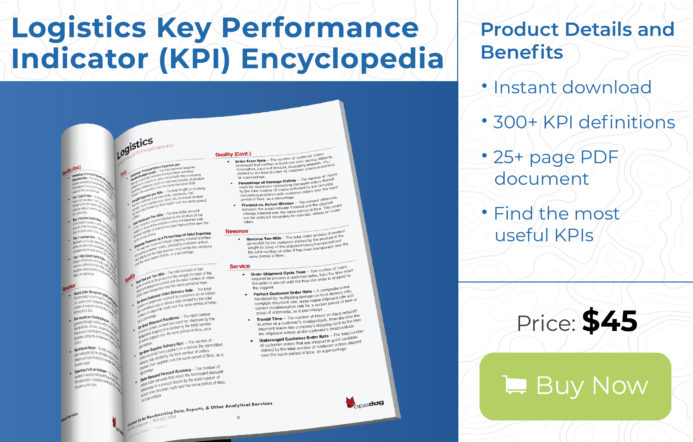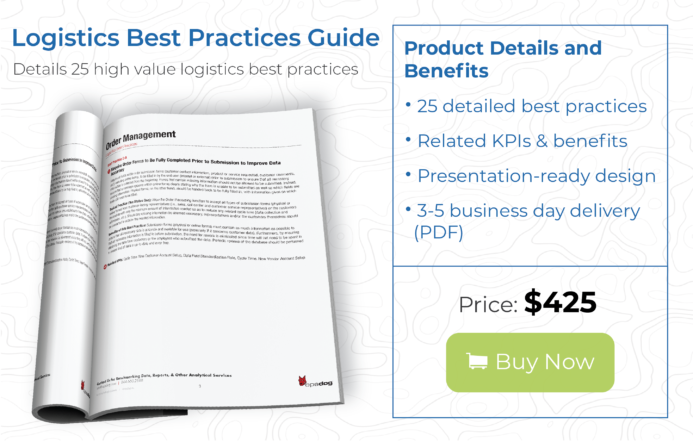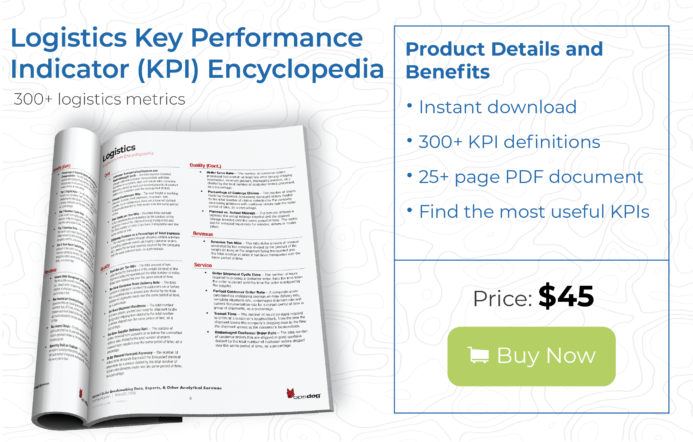When you think of perfected logistics management, you probably think of the biggest player in the industry, Amazon. From effective acquisition of goods, control procedures, and the storage of goods from point of origin to consumption, they regularly meet and even exceed customer expectations while maintaining high margins. From the company’s warehouses to the customer’s front door, there are numerous logistics Key Performance Indicators (KPIs) you must measure to benchmark where you stand against competitors and what you can change to bring a positive boost to customer satisfaction ratings and keep overhead costs in check.
What are Logistics Key Performance Indicators?
Logistics Key Performance Indicators are defined as the quantitative values used to determine how efficiently and effectively specific logistics operational goals and objects are achieved by the company over a certain period of time.
Urgent business questions that KPIs for logistics seek to answer include:
- What percentage of promised shipping deadlines are missed?
- How many customer orders arrive damaged per month?
- How many customers received the wrong order?
- How many customers wait extended periods of time to receive their order because it is out of stock?
- Am I maximizing the utilization of shipping methods?
Only once you start to measure and compare the above items, will you be able to analyze why they are happening and what their cost is to your business.
If logistics managers fail to measure and keep track of the logistics performance indicators, customers could end up being so dissatisfied with erroneous, damaged or late packages that they will no longer be willing to do business with the company. On top of losing business, high numbers of dissatisfied customers can waylay the company’s marketing efforts by warning away potential customers with negative online or verbal reviews which can further cause sales to slip. Utilizing the right logistics key performance indicators can jumpstart a reduction in the number of dissatisfied customers, thereby improving the company’s overall bottom line.
Below are 4 logistics key performance indicators that logistics managers should be measuring to ensure they too can exceed customer expectations and boost satisfaction in all areas.
Logistics Key Performance Indicators Example # 1: Perfect Customer Order Rate
If a logistics department was a school room, when it comes to customer satisfaction, this is where they need to score an A+. Measuring the Perfect Customer Order Rate KPI should be at the top of every logistics performance indicator list. This KPI for logistics is a composite score of quality, accuracy and completeness, which takes into account the average on-time delivery rate, complete shipment rate, undamaged shipment rate and the correct documentation rate of a group of shipments. A logistics company who finds that they have a low value for this logistics performance indicator might be experiencing issues concerning their material handling, or packaging processes which can cause a high number of products to be dropped, mishandled, or mislabeled. This can be increase a company’s risk profile as many products, such as pharmaceutical drugs or chemicals, need to be handled with extreme care and packaged in a very specific way. Any deviation can cause a large amount of products to be recalled as well as unforeseen complications to the health of customers. No matter the case, the end result of an order not arriving in perfect condition is a sub-par customer experience which can cause increased return processing costs, the loss of the customer’s business and unnecessary liabilities.
By tracking and documenting the separate components of the Perfect Customer Order Rate logistics Key Performance Indicator, logistics managers can begin to identify the root causes of problems and solve them before they become unmanageable. Root causes may concern logistics employees that need to be better trained or performance managed, customer order data entry processes that are too non-standardized, high amounts of products that are out of stock, or even sub-par materials handling and packaging documentation. Only with insight into root causes with logistics KPI analysis can logistics managers improve both the company’s customer satisfaction rates and the company’s bottom line.
Logistics Key Performance Indicators Example # 2: Undamaged Customer Order Rate
The Undamaged Customer Order Rate logistics performance indicator is a component of the Perfect Customer Order Rate KPI that should be monitored to ensure orders are making it to their final destination undamaged and in one piece. There is nothing quite as irritating for a customer to open a package they have been waiting for, only to find it broken due to improper packaging, or employee handling through the shipping process.
Do you want your business to pay more for processing returns and performing a high amount of rework? No, of course not. No one wants to pay more money and waste valuable time, especially if such instances can be remedied by tracking logistics key performance indicators. If you find yourself with a low value for this logistics Key Performance Indicator, inspect how employees fill, package, and ship the customer order to locate the problem. Perhaps there are poor material handling procedures in place that lead to a large amount of damage to goods during the shipping process. Keep in mind that the reason behind damaged orders could even lie in poor vendor management (goods arriving from suppliers already damaged).
Implement procedures to better handle materials, utilize effective packaging methods, and lower the number of checkpoints for customer orders to reduce the number of instances customer orders are damaged. Then watch as customer satisfaction grows! Be sure, however, to continue tracking this logistics performance indicator, even once the value has risen so as to not slip back into old habits.
Logistics Key Performance Indicators Example # 3: Fleet Capacity Utilization
A half-packed truck leaves the facility to deliver orders, leaving behind packages that are loaded into a second truck headed in the same direction. Sounds like a waste of manpower and resources, doesn’t it? When shipping capacity isn’t being utilized to the fullest, shipment delays can occur, leading to a decrease in customer satisfaction due to longer than expected wait times. Not only is the customer impacted by this underutilization, but the amount of money and time the logistics company spends on labor increases dramatically as more hours are spent on customer order preparation, packaging and shipping, than would have been needed if the initial truck had been loaded to capacity.
The Fleet Capacity Utilization logistics Key Performance Indicator compares the shipping capacity used for all of the company’s shipments to the total shipping capacity available. The total shipping capacity available is defined as the theoretical maximum number of pounds all the vehicles in a company’s fleet can transport. Seek to improve package planning processes to ensure that boxes will fit easily together, which can help to not only increase capacity utilization, but to also reduce the number of goods being damaged by decreasing the amount of movement the goods are exposed to during transportation.
A perfectly loaded truck, utilizing all its maximum available space, delivers packages on, or ahead of time. But that’s not all. A properly loaded truck will scale back labor and fleet maintenance costs since less drivers will be needed and fewer trucks will be dispatched over time. Proper packaging and storage within the vehicle reduces the amount of space the products have to jostle against each other which reduces the chances products have in becoming damaged and needing to be returned.
Logistics Key Performance Indicators Example # 4: Customer Backorder Rate
Heavy demand can sneak up on the most prepared of companies, and if a company is inefficient with its demand planning, customers are going to be headed elsewhere to fulfill their orders. Why risk a dissatisfied customer base and missed revenue capture when you can measure the Customer Backorder Rate logistics Key Performance Indicator to get to the root of the problem of revenue lost from cancelled orders on backordered items.
A high number of delayed, or backordered, customer orders compared to the total number of customer orders placed points to process improvement opportunities in demand planning and forecasting, inventory management, vendor management methods, or even inventory shrinkage due to damage or theft. To keep customers satisfied, start by having managers estimate historical demand, as well as current market trends to ensure that the company’s products are never out of stock. Be sure to stick close to the forecasted numbers though, since having too many products in your inventory can cause your overhead costs to skyrocket.
Logistics Key Performance Indicators Final Thoughts and Resources
There are many logistics performance indicators to analyze if your customer base is slipping away from you, but only by measuring and benchmarking the right logistics Key Performance Indicators can logistics managers identify and address issues. Customer satisfaction is invaluable in the logistics industry, where the bar is constantly being raised by top performers in the industry. When switching to another company is easy for consumers, keeping an eye on these KPIs for logistics and other metrics, will give you a boost when it comes to holding onto your current customers and bringing new business in as well.
Are you looking for a full list of Logistics KPIs? Download our Logistics Key Performance Indicator Catalog here.
Do you need help delivering first-class and competitive logistics service to your customers? Contact us for information concerning our Benchmarking Research and business intelligence implementation service and we’ll quickly help you benchmark your business and provide you with presentation-ready deliverables at an affordable price.


